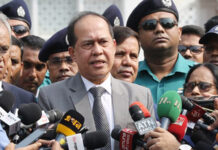
Photographer: Peter Yeung/Bloomberg CityLab
Dhaka’s air quality is among the world’s worst, due to traffic, construction, and industrial pollution. For its 20 million residents, solutions are desperately needed.
Peter Yeung
Rush hour along Dhaka’s Kazi Nazrul Islam Avenue, a serpentine road that bisects the Bangladeshi capital, resembles a chaotic citywide evacuation.
Thousands of cars, motorbikes, auto-rickshaws, vans and double-decker buses, all vying for an inch of space, crawl forward like an urban glacier, spewing out great clouds of sulfurous exhaust.
“It’s terrible here,” says Rakibul Hasan, a 24-year-old selling bus tickets on the side of the street. “My nose is always blocked; it’s filled with dirt. I’m coughing all the time. It doesn’t take a doctor to see that this is not good for my health.”
By many measures, Dhaka has some of the worst air pollution in the world. The South Asian megacity regularly tops the rankings of IQAir, a real-time worldwide air quality monitoring index. The city’s average readings for PM10 — coarse particles of pollution like dust — and PM2.5 — fine particles mostly created by combustion — were six and nine times greater than World Health Organization guidelines between 2003 and 2019, according to a recent study in Frontiers for Sustainable Cities.
“Dhaka is the new ‘Big Smoke,’” says Ahmad Kamruzzaman Majumder, using an old nickname for coal-shrouded Victorian London. He’s the director of the Center for Atmospheric Pollution Studies at Stamford University Bangladesh, which he says is the only dedicated center for air pollution study in South Asia. “Air pollution has a tremendously negative impact on all people living in Dhaka, for those in posh areas and slums alike. It’s a dire situation that we are far from solving.”
Research published in January by Majumder found that construction is the highest contributor to Dhaka’s pollution — 30% of the total — as the city sprawled from about 50 square kilometers in 1990 to 300 square kilometers today. A near second, at 29%, is industrial pollution from the 1,000 brick kilns and other factories across the city. Vehicles emissions add a further 15%; “transboundary pollution” from neighboring India, Pakistan and Nepal make up 10%. Activities such as burning waste and wood-fired stoves represent the remainder.
“What’s so troubling is how complex and wide-ranging the sources of Dhaka’s air pollution are,” says Majumder. “And yet we are very far from even beginning to clean up the problem.”
The toxic air is having a deadly impact. The average person in Dhaka loses about eight years of their life due to air pollution, according to a study by the Energy Policy Institute at the University of Chicago, which has ranked Bangladesh as the country with the world’s worst air pollution every year since 2018. Research published last April in Science Advances estimated 24,000 people in Dhaka died prematurely due to air pollution between 2005 and 2018, the highest among the 46 cities studied.
PM2.5 particles — small enough to bore through lungs, enter the bloodstream and damage internal organs — are linked to cardiovascular and respiratory diseases and cancer. This health toll is accompanied by a huge economic cost: The World Bank analysis found air pollution led to losses of between $11.5 billion and $13 billion in 2019, the equivalent of 3.9% to 4.4% Bangladesh’s GDP.
“We have a public health emergency on our hands,” says Abdus Salam, a professor at Dhaka University specializing in air pollution. “But because it’s not something the general public can easily observe and identify, it is being overlooked.”
Worldwide, air pollution is a major cause of premature death and disease, linked to an estimated 6.67 million deaths in 2019. A study of 6,475 cities across 117 countries by IQAir found that only 220 met WHO air quality standards in 2021. Many of the most intensely polluted urban areas are clustered in South Asia, home of nine out of the 10 cities with the world’s worst air pollution.
Rapid industrialization and growth has fueled the current crisis, as it has in many global cities since the Industrial Revolution. But Salam notes that regulations and technological advances have successfully cleared the air in many of the world’s most notoriously smoggy cities — from London’s turnaround to California and Japan after World War II. More recently, China has made progress since declaring a “war against pollution” in 2014, with some cities cutting air pollution by 30% through banning coal-fired plants, restricting auto use and improving enforcement. Beijing authorities, for example, can suspend factory operations if levels become too high.
Salam points out that while the European Union reduced limits on sulfur content in diesel for road vehicles from 50 parts per million (ppm) to 10 ppm in 2009, in Bangladesh, the limit is 350 ppm. Meanwhile, the 2012 Air Pollution Reduction Strategy for Bangladesh, the first national policy, “has not been properly implemented,” as the government hasn’t set targets, and the Clean Air Act, drafted in 2019 but not enshrined in law, is a “failed opportunity,” Salam says.
But Ziaul Haque, deputy director of the Bangladesh Ministry of Environment, says that more progress is coming. In 2020, the Bangladeshi government introduced a National Action Plan in 2020 to reduce air pollution in Dhaka and other cities through traffic management, improved energy efficiency and investment in renewable energy. Projects such as a metro rail system — the city’s first — and the 20-kilometer Dhaka Elevated Expressway are underway and the city’s first bike lanes were introduced in December 2020. These build on previous moves to ban leaded fuel, two-stroke engines and traditional fixed chimney kilns.
“We are fighting all the main sources and causes of air pollution,” says Haque. “The government has realized that air pollution is creating a huge problem for public health and our national economy.”
Going forward, Haque says Bangladesh will adopt an annual air quality management plan and broadcast public health alerts when pollution levels are high; the newly passed Air Pollution Promulgation Rules will give authorities greater powers such as to temporarily shut down factories, as in Beijing.
Authorities are also encouraging a shift to less pollution-intensive construction techniques: Government agencies will shift from using clay bricks, which must be fired, to non-fired concrete blocks. In the private sector, local company Concord is producing hollow blocks that use less concrete, while Kapita Auto Bricks’s hybrid kilns combine natural gas and solid fuel firing to reduce emissions.
Along Kazi Nazrul Islam Avenue, some signs of these efforts can be detected. A municipal truck sprays the street with water to combat the immense brownish haze of construction dust that often shrouds the streets, especially during the October-to-March dry season. About 30 meters above street level, the city’s mass rapid transit network is only partially complete — by 2030, the trains should span 128 kilometers.
Those on the ground are unconvinced that these measures will ease the problem. “The water spray is very irregular, and they don’t even do it here,” says Hasan, the bus ticket seller. “And the metro won’t help the lower-class people. It won’t make a difference.”
Bangladesh’s High Court has struck a similarly critical tone. In February, it censured the government for failing to comply with a nine-point directive it issued in 2020 to curb air pollution in Dhaka. In January and February, Dhaka recorded 13 days where air quality index levels — which cover ozone, carbon monoxide, sulfur dioxide and nitrogen dioxide and particulate matter — exceeded 300, which is rated as “hazardous” air.
Officials and independent experts agree better data must be gathered in order to set objectives. The World Bank, which led the last in-depth study of Bangladesh air quality in 2013, has called for an expansion of “the scope and accuracy of the air pollution data captured” as well as the addition of more monitoring stations — currently only 13 monitors have been installed. Haque said that the government aims to begin work on a World Bank-supported study in October. A team from the BRAC University JPG School of Public Health also recently installed eight air pollution monitors as part of a study this year. Unlike those installed by the World Bank, which are mostly high up on buildings, these devices focus on “human level” monitoring.
On the second floor of a house in Shyampur, a slum on the southeastern edge of the city, the university’s team is installing one monitor. “There’s still so much we don’t know,” says Kamrul Hasan, one of the researchers. “In most places, air pollution is the worst during the day. But in Dhaka, it spikes at night time. We don’t know why exactly.”
But for those on the frontlines of the world’s worst air pollution — which is set to get only more intense with greater urbanization and more extreme weather — answers need to come soon.
Shyampur, an informal settlement of tin shacks built on a wetland, is just meters away from a steel rolling factory that pumps out vast plumes of gray smoke. On a handheld monitor, the PM2.5 level hit 561 — more than 37 times the level the WHO considers healthy to breathe over a 24-hour period.
“I cough the whole night long,” says Rahima Bibi, an 80-year-old resident. “All the clothes get dirty because of the smoke. It’s every day, 24/7.”
Her neighbor, Mohamed Matin, is a former rickshaw driver who was forced to quit after experiencing chronic breathing difficulties. “Walking up stairs is difficult,” says the 46-year-old, who now uses an inhaler. “I can’t do hard work anymore. I think the smoke and the dust caused the problem. The government must take action.”















